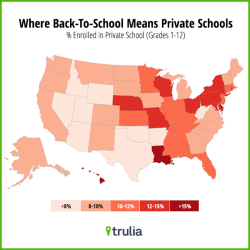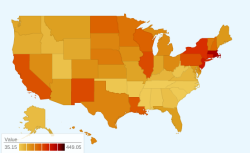 Finally! The map I have long wanted to see: Which states send kids to private schools in large numbers.
Finally! The map I have long wanted to see: Which states send kids to private schools in large numbers.
It’s one of those obvious statistics that should have been easily accessible, but I’ve never had luck in finding it. I found the results corresponded with my biases pretty, though with some exceptions:
- I’m not surprised that it’s most prevalent in the northeast (broadly defined), though I would have expected it to go further east into Massachusetts and Connecticut and wouldn’t have figured that it would count Ohio. I suppose with Massachusetts having one of the best school systems in the country, it’s not particularly necessary. Perhaps also, Massachusetts sending many of its best and brightest to public schools may help keep it on the top of public schooling lists. Then again, Maryland has good schools and still a lot of people going to private schools.
- Less common in the South, excepting Louisiana. The Pelican State has a robust Catholic schools. I didn’t particularly expect Mississippi and Alabama to be outliers, and if guessing would have guessed that they’d have lower numbers than Dixie’s eastern seaboard.
- I would have been surprised by Wisconsin, though that came up during the recall elections and whatnot, that private schools were more common there. I’m not sure why.
- By far, the most surprising state was Nebraska. Really, I would have figured that the central column of states would be relatively similar. Instead Texas and the Dakotas are low, but the others are high. While Nebraska is the biggest surprise, I wouldn’t have expected Kansas or Missouri, either.
- It’s interesting, if not surprising, that both Utah and Idaho have such low rates. One can imagine an alternate history where the LDS has its own school system the way that Catholics have theirs. Instead, with the degree of social domination they have over Utah and eastern idaho, I suppose they had their Mormon schools in the public school system and having private Mormon schools would have been a duplication of effort.
- Hawaii. Huh. I’m not surprised, because I wouldn’t have hazarded a guess. But it does kind of stand out.
- There is less variation between the states than I would have guessed. You have some below the 8% cutoff so they could have next to none. There aren’t many at the higher end, though, and that surprised me a little bit. Off the deep end, though, it’s just Louisiana, Delaware, and Hawaii.

- Since Catholicism likely affects the rates, I am including a map with that data point to compare and contrast. Obviously, this is likely to be more pertinent in some places than others. For example, the higher rates in California are due no doubt to the higher Hispanic population, which may not track with private school attendance the same way that it would in Louisiana. It does a good job of explaining Louisiana, for example, and Rhode Island. Less so for the Hispanic states, and you would think that it would lead to higher rates than Massachusetts.
Category: School
About the Author
11 Responses to Support Your Public Schools?
Leave a Reply
please enter your email address on this page.

I can maybe speak to Ohio, having grown up there and actually having gone to a private high school there. Much of Northeastern Ohio was settled (originally, in the early 1800s) by people from Connecticut, and to a lesser degree, Massachusetts. (The town in which I grew up – in the so-called Western Reserve of Connecticut, still, even in the 1970s and 80s, looked and felt much like a small New England town).
Likely some of the same attitudes were carried in. And I think some of the private schools were originally established in the decades after early settlement (the one I attended was. I think it had closed for a while in the late 1800s but was later revived).
I remember there were a number of private schools in the area; our teams played a bunch in and around the ritzier suburbs of Cleveland and I think there were a couple of Day Schools in some of the larger towns/smaller cities.
I will say my private high school experience was excellent, the first time in my life I actually felt like I had lots of friends my own age. The school kind of had the reputation of being a nerd magnet which is probably why I felt I fit in better. Also I was academically challenged to a greater degree than I had been, which also served to keep me happier.
Thanks for chiming in!
I used to joke with my wife that if ended up in Deseret, we’d need to send our kid to Lutheran school for “a good secular education” (in comparison to the Mormon-dominated public schools). Joke aside, the “fitting in” thing is a genuine concern. Having gone to a nerd magnet school, Clancy is high on the concept, if not private school particularly.
Hawaii has a tradiation of the missionary private schools. Since WWII, anyone who wanted their children to go to college on the mainland (like President Obama) went to private school. The public schools were just make work programs for the public sector unions and were not very good.
That makes sense.
I grew up in a heavily Catholic city in Connecticut that had more than ten parochial* elementary schools and a couple Catholic high schools. By the time I came along they weren’t as popular as they had been in their heyday a generation earlier, but most of them were still doing well. In fact, while there’s been some consolidation most are still around today.
It’s hard to generalize from a relatively modest number of examples, but as best I could tell may of the parents who sent their kids to Catholic schools fell into one of three categories: 1) devoutly religious people; 2) snobbish parents who didn’t think the public schools were “good enough” for their precious little muffins (in fairness, some of the public schools were pretty bad), or 3) probably the biggest group, parents who figured that their kids might run amok in public school and needed the tougher discipline of Catholic schools.
My own Catholic school experience was limited to first grade. My parents sent me there mainly because the public school in our district was widely acknowledged as one of the worst in the city. I have almost no memories of that year, but from what I understand the teacher was inexperienced and in charge of a class of 40 – yes, 40 – small children. We moved to a better district after that year and from then on I attended public school.
* = not all Catholic schools are parochial schools. The term means a school operated by a local parish, almost always an elementary school. A school run by the regional Catholic diocese is a diocesan school, while a school run by a religious order of priests, monks or nuns (like the city’s best Catholic school by far) is simply a religious school.
I was really expecting Connecticut to stand out more, as a high-private state.
Connecticut has some very upscale prep schools (Choate, Hotchkiss, The Gunnery, Miss Porter’s, Taft), but by no means are all of the students from the state. It also doesn’t have many non-Catholic religious schools.
Outside of Southeastern CT (otherwise known as Fairfield County), it’s not exactly the richest state. Plus, given the reputation of Yankees as stingy people, I don’t think they’d squander perfectly good money on private schools if the local schools are suitable.
I asssume you mean SWCT.
though I would have expected it to go further east into Massachusetts and Connecticut
Even though those states have a sizable number of Catholics, if the local schools are good enough, there just aren’t the same incentives to send your children to Catholic school, especially if you spent a decent chunk of your income on buying a house, and the local parish offers CCD classes (what Protestants call ‘Sunday school’) for religious education. Remember that places like Boston and Fairfield County have high housing costs.
FWIW, NYS’s count is somewhat inflated because New York City has such a large school system where even in middle class areas, there’s a sizable number of parents that aren’t willing to trust the local schools. I’ve seen plenty of non-Catholics including non-Christians send their children to Catholic school to save their children from the questionable local public schools. Plus, I suspect that the higher numbers of families that can afford the real $30K a year private schools along with the children of UN employees plays some role in skewing the numbers. Mind you, eventually, the high cost of Catholic school will force a decline in enrollment, and the charter school movement has served as a bit of an escape valve for those who can’t afford Catholic schooling.
Less common in the South, excepting Louisiana.
I suspect it’s because in the South, homeschooling is seen as the alternative to private schools.
Less so for the Hispanic states, and you would think that it would lead to higher rates than Massachusetts.
I suspect it’s because Hispanic immigrants tend to be poorer, and thus unable to afford Catholic school, but also because the infrastructure of previous generations of immigrants going to Catholic school is simply much weaker in states with high Hispanic populations, since most of their growth is from the post-WWII period. Plus, despite the meme of Mexicans being super religious, Mexico has had anti-clerical movements at certain points, and most Mexicans go to public schools run by the state in Mexico. Compare that to Germany where public school students go to mass on the first day of school in some areas.
Catholic school tuition was remarkably cheap until about the 1950’s. Most or all of the teachers were nuns, who were under vows of poverty and received very small stipends for their work. As the number of teaching nuns declined, however, the schools had to hire regular teachers and pay them regular salaries (which, granted, are usually less than public school salaries). Tuition had to rise.